 Ania Szremski
Ania Szremski
Soft numbness gives way to surprising politics in an
exhibition at Pace Gallery.
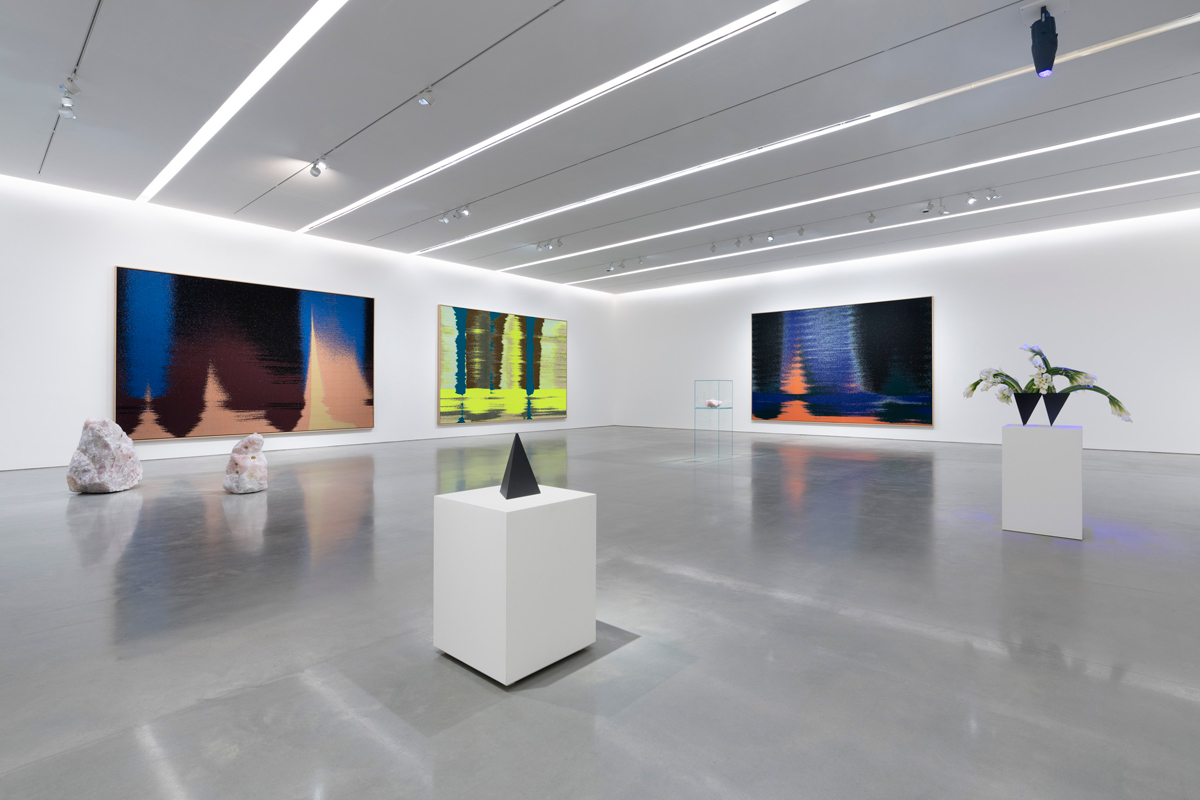
Mika Tajima: Energetics, installation view. Courtesy Pace Gallery.
Mika Tajima: Energetics, Pace Gallery, 540 West Twenty-Fifth Street, New York City, through February 24, 2024
• • •
Mika Tajima’s ongoing Negative Entropy series, seven examples of which appear in Energetics, her solo exhibition at Pace in Chelsea, are woven representations of human energies. The artist started the series in 2010, during a Fabric Workshop residency in Philadelphia. She began by recording harmonics produced in industrial sites (like a Jacquard loom weaving factory), converting the audio files into visual spectrograms, editing those for color and entropic noise, and then sending the image files to be translated into tapestries. The idea was to create an impression of energy in a space—the energy produced by individual and collective labor—which takes its final form through additional layers of labor: the sound engineer, the artist, the weaver (and, for the viewer in the gallery, the extra mediation of the art handlers, the communications team, the sales associates).
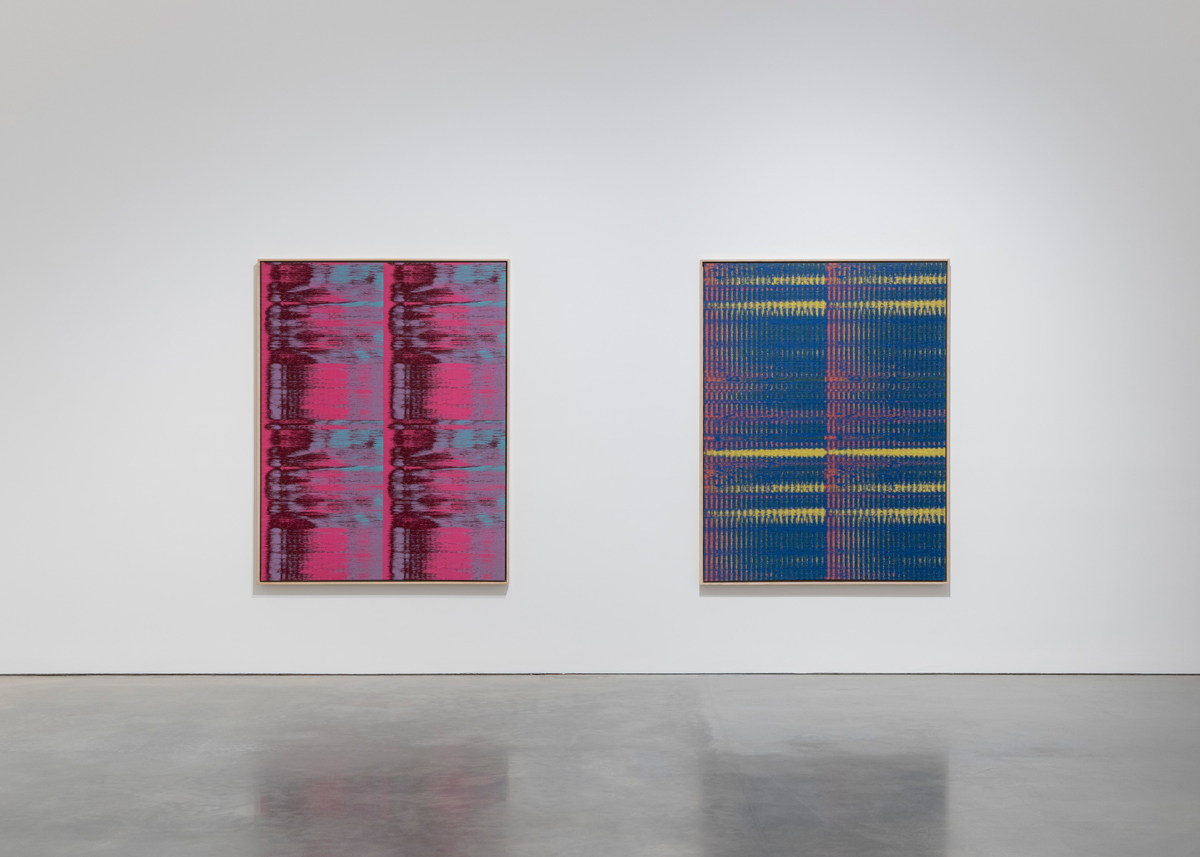
Mika Tajima: Energetics, installation view. Courtesy Pace Gallery. Pictured, left to right: Negative Entropy (Inscape Holding Breath Meditation, Quad), 2023. Cotton, polyester, nylon, wool acoustic baffling felt, and wood, 72 × 55 inches. Negative Entropy (Yokohama Symphostage, Drilling Excavation, Blue, Quad), 2023. Cotton, polyester, nylon, wool acoustic baffling felt, and wood, 72 × 55 inches.
Negative Entropy (Yokohama Symphostage, Drilling Excavation, Blue, Quad), a field of deep aquamarine with stuttering lines of fuchsia repeating vertically and lines of mustard yellow stammering horizontally, is based on a recording at a huge construction site in the eponymous city. Negative Entropy (TAE, Test Shot, Inner Divertor Operation, Norman, Orange, Single), a smaller, synthetic meld of industrial orange, yellow, and black, interprets activity at a high-tech energy-fusion company in California. More recently, the artist has moved toward mapping the resonances of a different kind of energy production—that of communal meditation, such as the psychedelic waves of magenta, teal, and purple representing the energies vibrating at a luxury spa center servicing tech-bro types—(Inscape Holding Breath Meditation, Quad)—or the shimmering grid of yellow stripes depicting the energy fields at a temple in the center of Tokyo, where office workers go to pray at the break of morning to regulate themselves before heading off to their jobs—(Seishoji Priest Prayer Drumming, Pale Yellow, Quad).
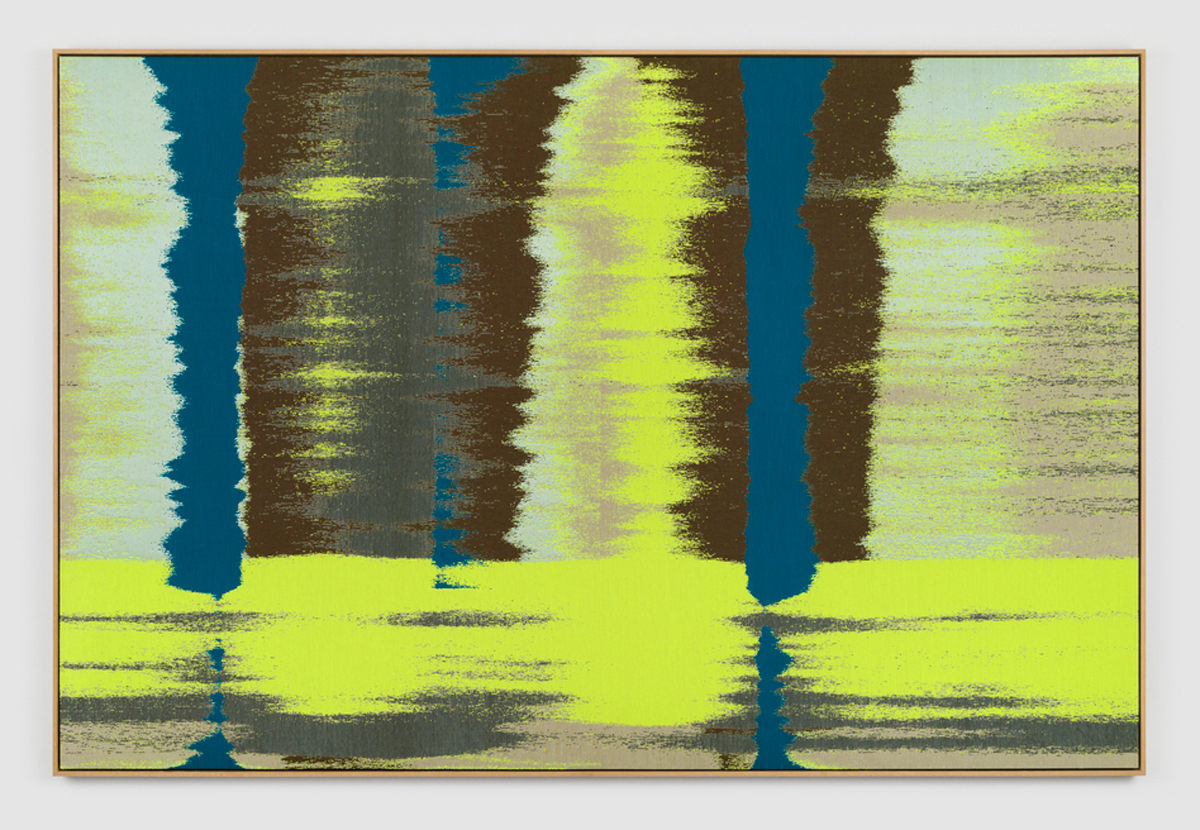
Mika Tajima, Negative Entropy (Deep Brain Stimulation, Yellow, Full Width, Exa), 2024. Cotton, polyester, nylon, and wood. Courtesy Pace Gallery. © Mika Tajima.
The most dramatic statement in the exhibition is made by a suite of three newer works in the series from 2024, fabricated on an architectural scale (each roughly eleven feet high and seventeen feet wide), which are giant snapshots of scans of brains undergoing deep electric stimulation as a treatment for Parkinson’s. These, more than the others, are hard to look away from, compelling in their size and rich, saturated colors. You wouldn’t know they were specifically capturing brain waves unless you consulted the checklist, but they are undeniably, soothingly biorhythmic, smearing in the mesmerizing techno-palette of screen-based hues.
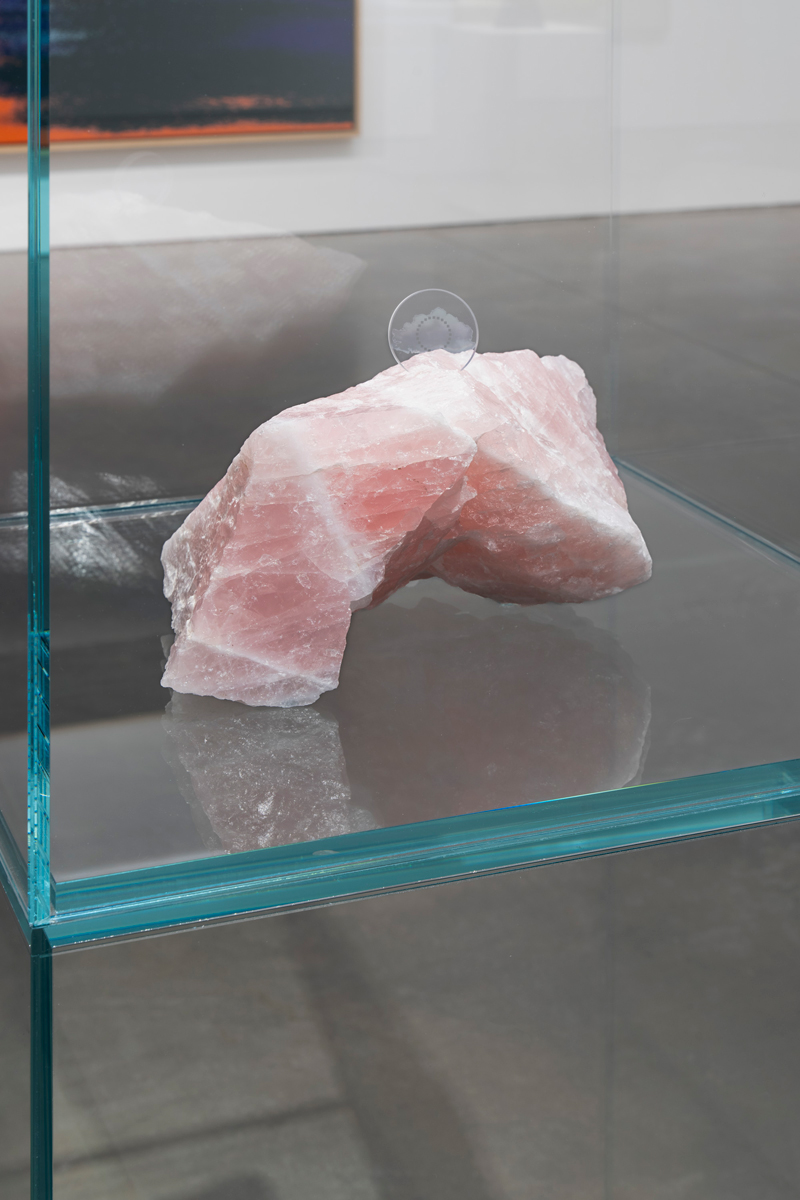
Mika Tajima, Sense Object, (January 1st, 2023, United States), 2023. 5-D memory crystal encoded with sentiment data (twenty-four hours’ worth of Twitter data from the United States), rose quartz. Courtesy Pace Gallery. © Mika Tajima.
Contrasts in scale are important in this show—the greatest amount of produced energy, at the fusion plant, is represented in the smallest tapestry; the tiniest of micro-moments in an individual brain are blown up to beyond the human. Then there’s the sculptural object placed in the vitrine at the gallery’s far wall, in front of one of the brain stimulation pieces. Here, a translucent disc is embedded in a piece of rose quartz roughly the size of two fists (Sense Object, [January 1st, 2023, United States], 2024). The disc is a 5-D ocular memory crystal, developed by data scientists in the UK, which can preserve an unfathomable amount of information for one billion years. Onto this crystal Tajima has inscribed a data set of feeling: on New Year’s Day, 2023, she downloaded every post uploaded by American users onto X (formerly known as Twitter), then filtered the messages for those conveying affect—this vast field of emotion is now held in that coin-size crystal.
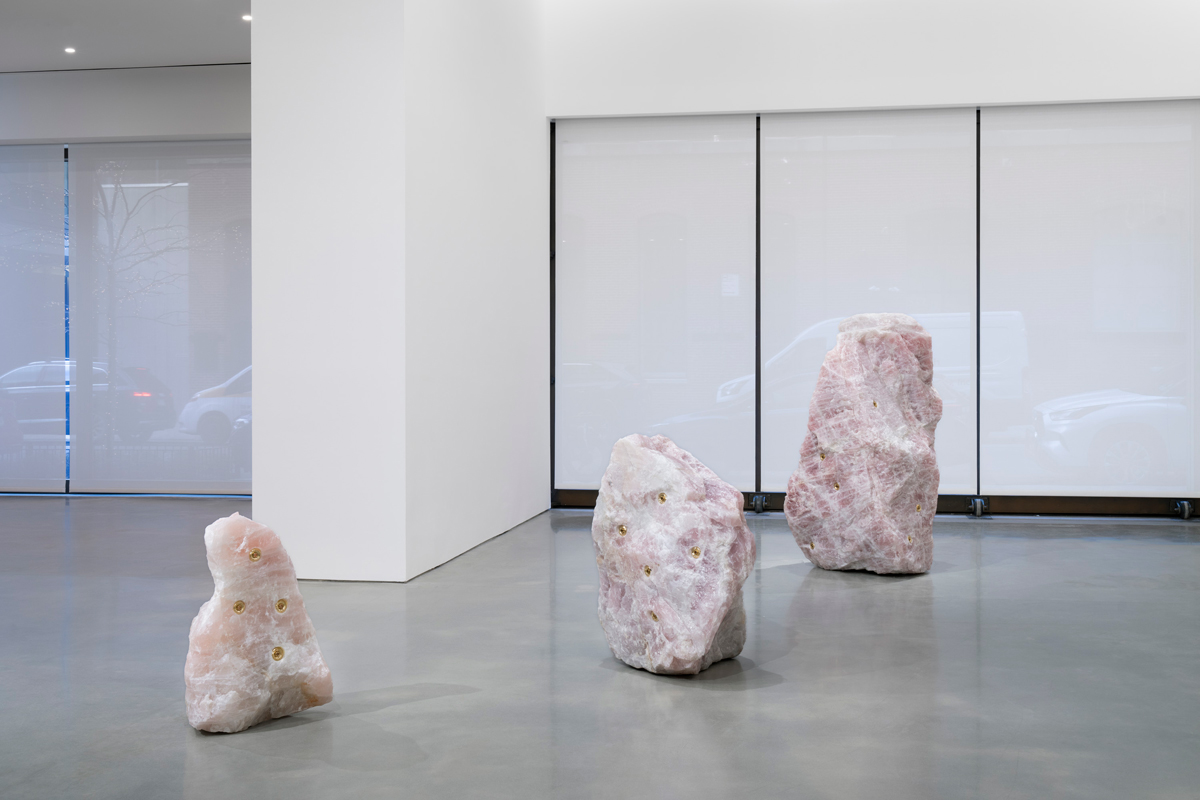
Mika Tajima: Energetics, installation view. Courtesy Pace Gallery.
Three more rose quartz objects are to be found across the gallery, to the left of the entrance, which are much larger, ranging from the size of a child to a preadolescent. These are from the artist’s Pranayama series, the title the Sanskrit word for “control of vital air,” an ancient Vedic breathing practice aimed toward mental liberation. Into these crystals Tajima had bored several holes that roughly map acupuncture points, which she then fitted with cast-bronze hot-tub-jet nozzles, as if allowing the rocks to breathe, to be permeated by air, but also, theoretically, expel it. To the right of the space, three obsidian-colored inverted pyramids hold cut flowers (white spider mums when I was there, each bunch leaning in a different direction in its vase; Tajima changes the type of flower and its arrangement, based on the Japanese ikebana tradition, every week). The blossoms glow in a UV fluorescence transfusion as they move toward death. As you take these pieces in visually, you also take in another through your nose, a pleasing scent emanating from a diffuser on a low plinth to the right of the entrance which, according to the press release, is made from materials related to ancient divination practices. (In the past, Tajima has crafted incense out of the materials used in smoke-reading rituals mixed with psychoactive mushrooms.)
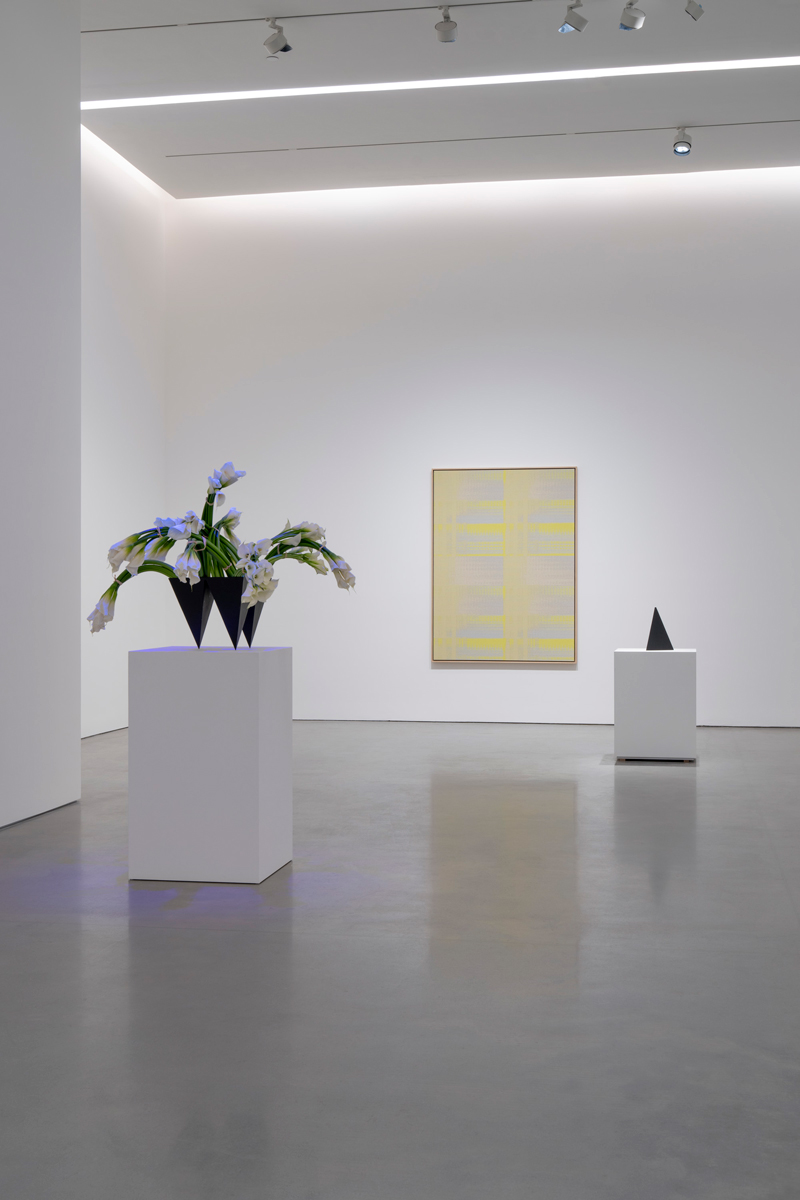
Mika Tajima: Energetics, installation view. Courtesy Pace Gallery. Pictured, left to right: Naturans, 2024. Steel, fluorescence, solution, and live cut flowers. Negative Entropy (Seishoji Priest Prayer Drumming, Pale Yellow, Quad), 2023. Vipassana, 2024. Peppermint leaf, eucalyptus leaf, yerba santa, rosemary verbanon, geranium oil, citronella oil, rose damask oil, eucalyptus globulus oil, psilocybe cubensis, vaporizer, steel, and wood.
As much as I found the ideas behind these pieces fascinating, as well as the way those ideas seemed to echolocate each other across the space, the works also have a congenial ambient effect that chagrined me—like they are artful more than they are art; conceptual décor. It made me feel itchy—why make such unenergetic work about energy, and why at a time like this? Yet, Tajima has been intentional about crafting a softly numbing effect throughout her practice (like in her ongoing Art d’ameublement, a visual equivalent of Erik Satie’s “furniture music”—a series of paintings meant to fade into the background of consciousness). Early in her career, she organized an art collective called the New Humans, named for the Japanese term shin-jinru, or “new breed,” coined to describe the disaffected, media-gorged youth who came of age during Japan’s economic bubble in the 1980s and its subjectivity-defining bust. A certain diffidence is part of such a subject position—and works like these seem to be crafted out of that visual-emotional vernacular.
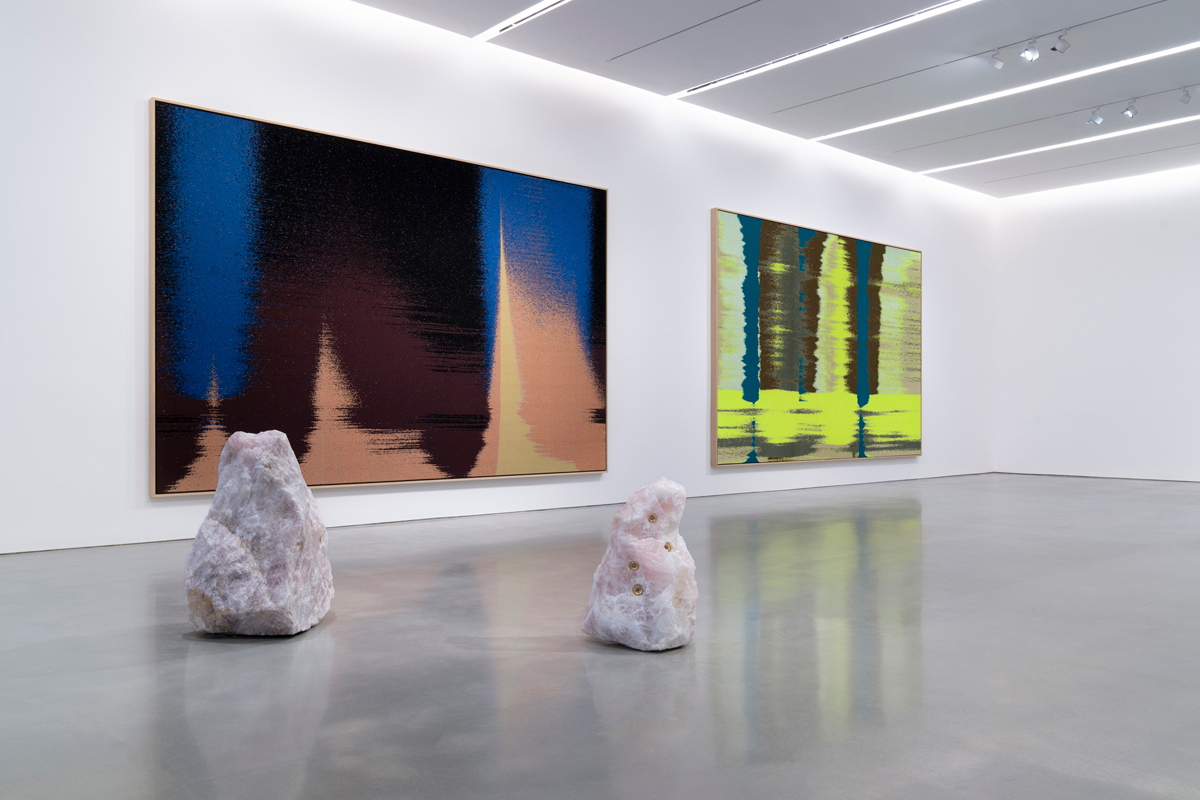
Mika Tajima: Energetics, installation view. Courtesy Pace Gallery.
Diffidence may be a key word. The pieces in Energetics withhold themselves, refusing to agitate the viewer’s nervous system with either challenging, uncomfortable friction or beauty of startling proportions. There’s something of Sianne Ngai’s notion of “stuplimity” here—a counterproposal to the uplifting transcendence of the Kantian sublime in reaction to an exciting object. Tajima, by using a certain kind of mundane aesthetic of luxurious repose (the soft pink of the rose quartz that’s become so popular for energy cleansing, the pedestrian jacuzzi jet nozzles, the bright, wavy visual imprints of once-powerful spiritual practices now demoted to life-hacks for increasing productivity), and presenting that in repetition, provides a satisfying dopamine hit, at first, and then a familiar fatigue—the contemporary American condition: the inertia of feeling.
Through this drowsy prettiness, she may also be slipping in a surprising politics. Looking at all these representations of energy on the individual, collective, and mass scale—especially the juxtaposition of the multiplicity of articulated emotions stored in the optical disc with the electric surges in a single mind—made me think of new studies proposing a quantum theory of consciousness, like one by Gangsha Zhi and Rulin Xiu published last September, which postulate “the large-scale, nearly instantaneous synchrony of brainwaves among different parts of brain, body, people, and objects.” We could wonder if, in some infinitesimal and unknowable way, our consciousnesses may be able to entangle together, and are less (or negatively, as per the title of Tajima’s series) entropic in so doing. In the artist’s work there’s on the one hand a critique of how late technocapitalism renders subjects as objects, through data mining, the capturing of our kinetic and emotional energy in labor and in leisure, and so forth, leeching us of vitality. But she is also intimating something that connects us—these enigmatic vibrations that constitute our selves—something that could open the possibility for a collective energetic power to resist that system.
Ania Szremski is the senior editor of 4Columns.